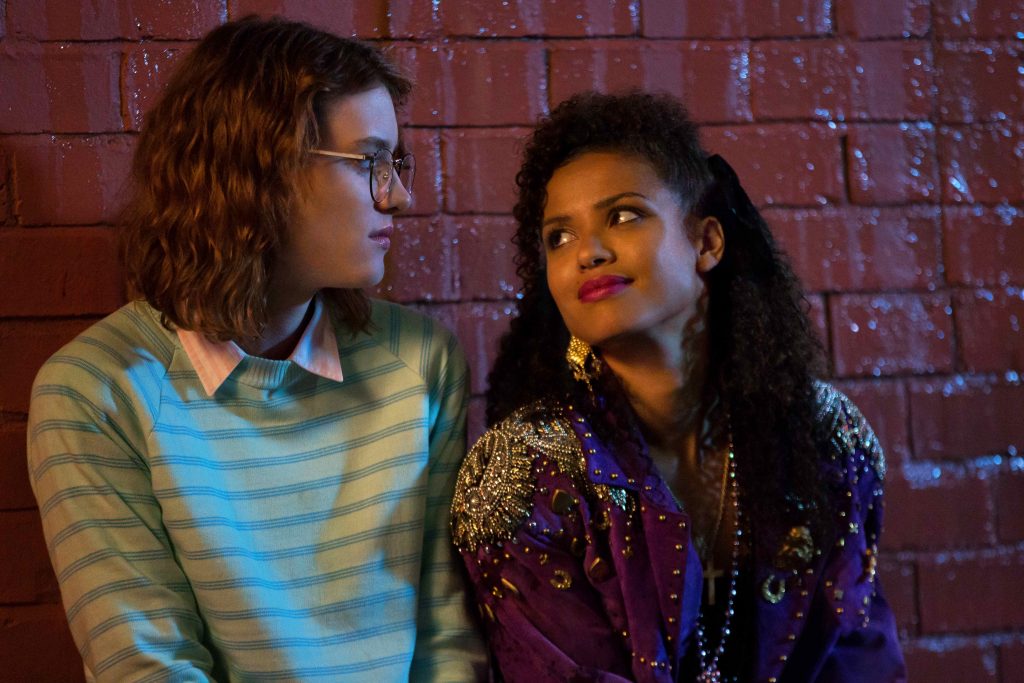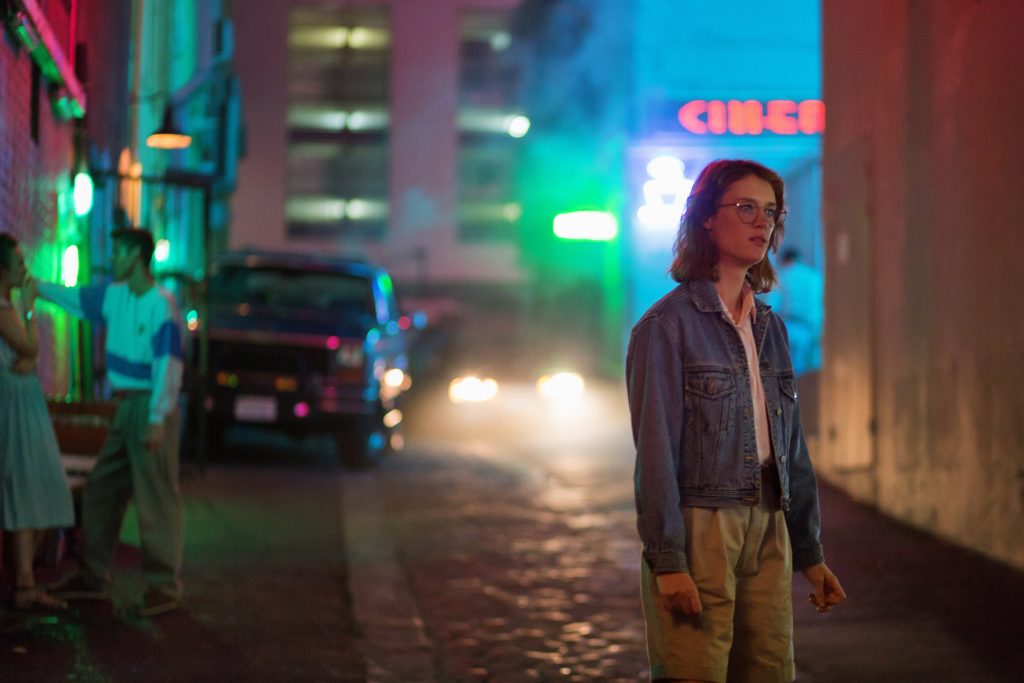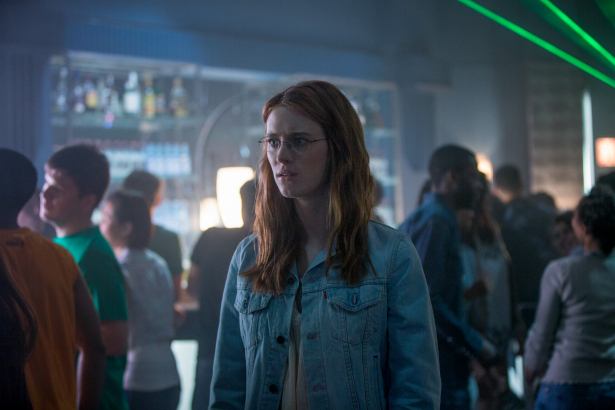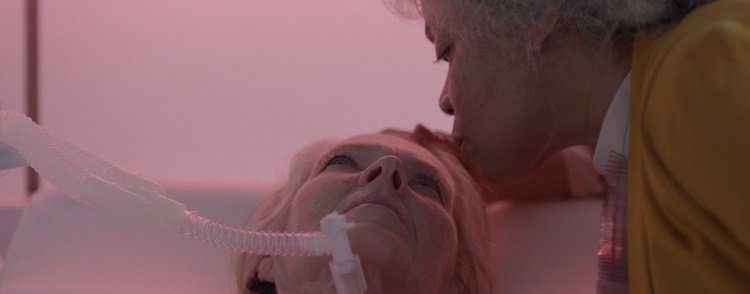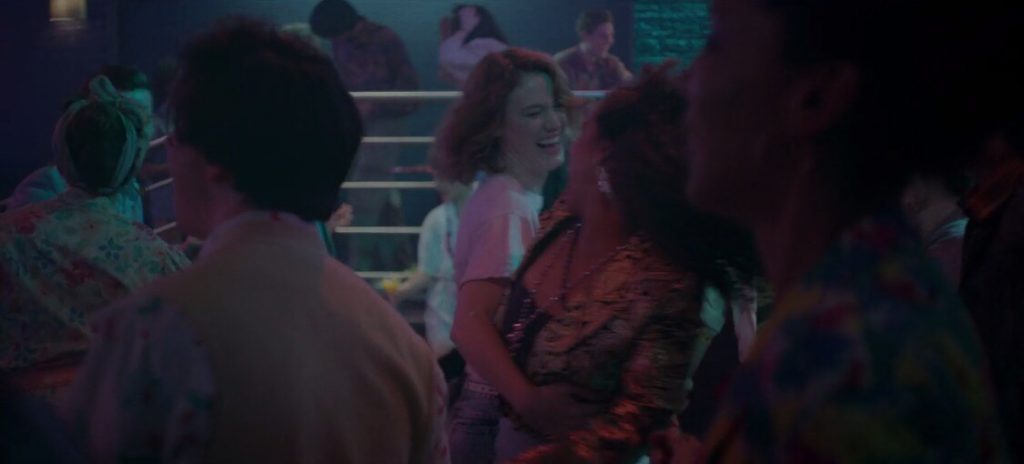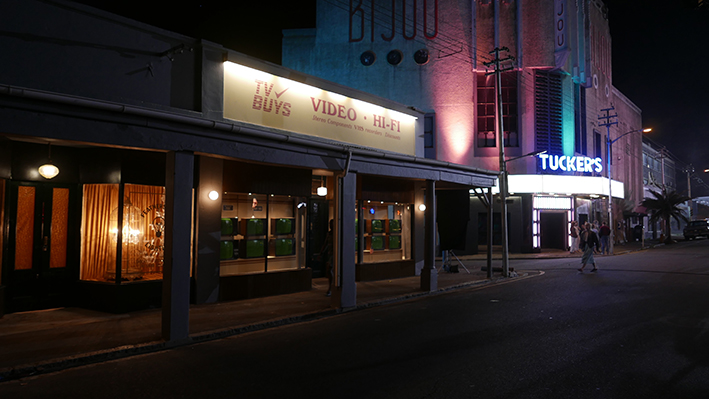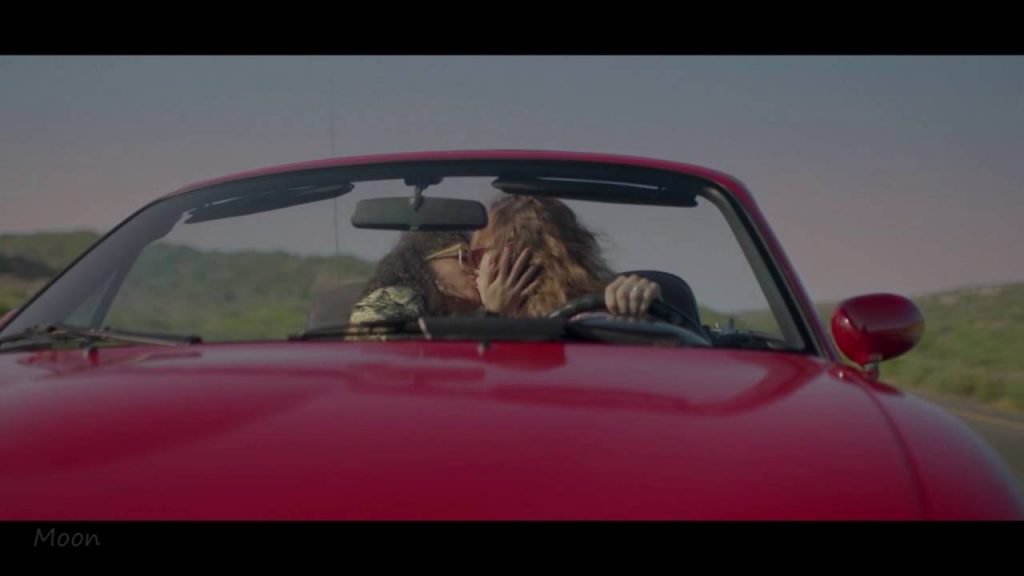In this world we’re just beginning
To understand the miracle of living
Baby I was afraid before
But I’m not afraid anymore-Belinda Carlisle, “Heaven is a Place on Earth”
The less you know going into “San Junipero” the better, even if you suspect Black Mirror isn’t your jam. Here are the technicals up front: Owen Harris (who previously directed for Misfits and Secret Diary of a Call Girl, as well as Black Mirror‘s own “Be Right Back”) directs the hell out of Charlie Brooker’s surprisingly restrained script. He captures the smoky, neon-drenched cinematic vibe of its 1987 setting, getting a strong assist from a soundtrack that throws in a couple of powerful deep cuts with a fun, reliable mix of standards. More importantly, Gugu Mbatha-Raw (Beyond the Lights, Larry Crowne) and Mackenzie Davis (Halt and Catch Fire, The Martian) deliver raw, layered performances that push this deceptively powerful story full steam ahead.
We’re in 1987, and we open on a plain young woman named Yorkie (Davis) on a tentative, lonely stroll through San Junipero, a “party town” that appears to be on the California shore. She wanders into Tucker’s, a flashy dance club, clad in oversized glasses and the kind of striped sweater-over-collared shirt ensemble you’d wear to school in that era if you were actively trying to avoid sexual intercourse. Naturally, she sticks out like a sore thumb against the glitter and wow of the various dance hall junkies. For a minute, she finds comfort within the club’s small arcade area, but the combination of an oppressive video game nerd and a driving game showing a horrific car wreck wards her off. Having no better ideas, Yorkie parks herself in a booth and tries to convince herself to be comfortable in her own skin while sipping bottled Coke from a straw.
Into this awkward mess storms Kelly (Mbatha-Raw), a spirited party girl who briefly caught Yorkie’s eye earlier. After helping Kelly drive away her own persistent suitor, Kelly treats Yorkie to what is clearly her first alcoholic drink. Yorkie is quickly swept off her feet by Kelly’s confidence, the casual energy that radiates from her, while Kelly’s smitten by Yorkie’s authenticity, her apparent refusal to be anyone but herself. This admiration sparks into a powerful attraction, but it’s a little too much for Yorkie. Kelly ultimately walks away, leaving Yorkie to kick herself.
The show cuts to a black screen; some curious beeping and clicking noises can be heard over it. You may make some assumptions off of that, but the show’s moving right along to a week later, with Yorkie trying out various looks that don’t seem to suit her. She eventually settles on a variation of her old look and makes another run at Tucker’s. This time, when she finds Kelly, Yorkie gathers the courage to admit that she wants to be with her—she just doesn’t know how. Kelly gently guides Yorkie back to her place, where they make love and compare histories. Yorkie’s obviously inexperienced, still trying to figure herself out; there’s an even further sense that she’s lived a very sheltered life up until recently. Kelly has a lot more mileage on her; she was married to a man she truly loved for a long time, despite constantly getting “little crushes” on other women. One day, he “chose not to stick around.” Now it seems like she’s just running out the clock, trying to have as much fun as she can before she goes. (It should be said that Mbatha-Raw is fantastic in this scene, deftly balancing a casual pixie-esque attitude with a real sense of suicidal pain.)
Speaking of which, Kelly checks the clock soon after and remarks “Time’s nearly up,” so they just lie with each other and enjoy the company. Once the clock strikes midnight, the world disappears.
Another week passes. When Yorkie returns to Tucker’s this time, Kelly is nowhere to be found. She pokes around some of San Junipero’s other haunts—including The Quagmire, a debauched nightclub that more closely resembles a cross between Pleasure Island and Thunderdome as opposed to the fun, flashy atmosphere of Tucker’s. Yorkie guns it for the exit, presumably before she can be shanked, only to run into a mutual acquaintance who suggests that she try looking for Kelly in “a different time.”
At this point, the “what-the-hell” of it all should start to fall into place; in fact, it’s possible that it fell into place the minute Yorkie looked uncomfortable watching that car crash in the video game demo. But despite the ominous musical sting that accompanies “a different time,” the episode doesn’t seem to care if your mind is blown at this point. You may have a few doubts and questions about the reality you’re being presented with, but everyone in San Junipero seems to know what San Junipero is, so there’s no reason to have the setting drive the story. In fact, if you rewatch the episode, you may be shocked by how thick they’re laying it on. Little things jump out at you: the video game nerd trying to get with Yorkie, mentioning that Bubble Bobble “was” one of the first games to have a different ending if it was played with two players. Or Kelly, complimenting Yorkie’s (disregard of) style, looking out to the crowd of dancers at Tucker’s and remarking “People try so hard to look how they think they should look. Looks…they probably saw in some movie.”
Either way, because everybody seems to know the score, Charlie Brooker is free to lay the groundwork of Yorkie and Kelly’s relationship and let that propel the drama. I’ve heard people complain that the episode felt too “light” to garner as much praise as it has, but Brooker can’t really make his point without making the case for Kelly and Yorkie, and that’s what he fearlessly does here. “San Junipero” is a textbook case of how effective sci-fi/fantasy is driven by characters and not concepts, and how that can make twists in a narrative more resilient to a viewer’s calculating mind. If you’re shocked by “try a different time,” great. But even if you’re ahead of the game, and you’ve figured out that San Junipero is some kind of virtual reality simulation well before the show is ready to confirm as much, you still can’t say the story is spinning its wheels; none of that stuff is directly pertinent to Yorkie’s journey of self-discovery or Kelly’s apparent issues with commitment.
We learn—no sooner than we need to and no later than we want to, thanks to Brooker’s skillful writing—that the San Junipero simulation is a heavily regulated program that serves as a place where a person can upload their consciousness once they die. In this world, you can look however you want, live in any era you’d like, conjure anything you need out of thin air, and even feel as much as you want. The living can visit, but most places will only allow five hours a week; many feel the risk of becoming addicted to the simulation is too great. For the moment, that’s Kelly and Yorkie; in the real world, they’re elderly women at the end of their lives who live a state apart. Kelly (played in reality by Denise Burse, also fantastic) is riddled with cancer and has been perusing San Junipero for a few months, while Yorkie is a quadriplegic who only recently agreed to give it a spin. Yorkie loves it and wants to “pass over”—end her life voluntarily and become part of the simulation forever. Kelly, however, for all the fun she’s having, doesn’t like the idea of “forever” in San Junipero and is prepared to fade into oblivion.
There are lots of questions that this episode inspires about its concept. You can consider the class angle: functional immortality via upload to the cloud can’t be cheap. You may ask yourself whether the kind of people who make it into San Junipero are the kind of people you want to spend eternity with. There’s also the question of the simulation breaking down; San Junipero is a giant computer, and computers can’t last forever. What if this perfect world starts to glitch, and things don’t come back the way they’re supposed to, if at all? (Speaking of which: If you’re really hardcore, you can bring up the Ship of Theseus paradox.) Those are good questions, I think; someone else could probably ask a few other good ones.
However, Brooker’s interest here lies purely in the philosophical questions—not his usual ethical ones—surrounding the idea of a digital heaven that can support your consciousness for long after your body dies. You can criticize him for writing such a shallow dive, and that might not be unfair. What Brooker does here, though, is turn those questions into a dramatic romance between Kelly and Yorkie. He spends the first half making the case for them as a couple, and for the realism of San Junipero, so he can spend the second half using all that to bring stakes to what is essentially a philosophical debate. What he loses in depth, he makes up for with elegance.
The couple is divided on passing over, and like any great argument, be it philosophical or dramatic, there isn’t really a wrong side here. Yorkie’s love of San Junipero may develop into something that seems blindly passionate, but it isn’t necessarily superficial or childish. She was born into an oppressively religious family, banished from her household the moment she came out to them, and got into her car wreck almost immediately after. She never got a chance to grasp, understand, and enjoy freedom; San Junipero is giving her that opportunity, miraculously turning back the tide of tragedy. Selfish? Absolutely. But what’s wrong with being selfish when she’s spent her entire life trapped—figuratively at first, and then literally, within her own body?
Kelly, on the other hand, has had plenty of freedom in her life—enough to know 49 years of marriage to a good man and 39 years of love for a daughter that died too soon for Kelly and too soon for San Junipero. To Kelly, her daughter can only exist in oblivion; same for her husband, who rejected San Junipero because it offered everything he could have ever wanted except the one person he really needed. Because her pain means nothing if it doesn’t, Kelly has to believe that the promise of death brings importance to the moments where she is alive. She brilliantly bolsters her point by bringing up The Quagmire, implying that the people who go there do so because they’ve been in San Junipero for too long and can’t feel anything short of extremes. More importantly, though, she knows that death will also bring her relief from the memories of the love she chose over her seemingly fleeting desires, and all the ways that decision hurt her once that love was gone. If she stays, that pain might haunt her for eternity.
We know that Kelly ultimately chooses Yorkie. If I have one complaint here, it’s that I really wanted to see that moment when Yorkie realizes that Kelly wouldn’t be going away after the clock struck midnight. Her and Yorkie’s fight before the reveal that they ended up together was devastating and ugly, and I wanted to see that relief on Yorkie’s face, that realization that all was truly forgiven and that everything was going to be okay. I wanted that moment of validating catharsis.
But would a scene like that actually detract from the episode by making it too upbeat?
I tend to prefer upbeat endings; naturally, I choose to believe the most upbeat interpretation of the episode. I think of Kelly, running away from her argument with Yorkie (who has already passed over at this point), purposefully wrecking her Jeep with two minutes left in her visit. (Eerily similar, based on what we know, to the crash that broke Yorkie’s body. The whole episode is built like a Swiss watch, with so many crucial narrative beats reflecting on smaller character beats, and vice versa; it demands multiple viewings to get it all.) She’s wounded, she’s angry, she’s scared, and the easiest thing for her to do would be to stay down and wait for the clock to take her from San Junipero.
Then Yorkie, seconds before midnight, appears and offers her hand.
It’s a neat trick to make you cheer on the heroine’s euthanization, but that shot of the liquid flowing through Kelly’s IV, timed to the power chord that properly kicks off Belinda Carlisle’s “Heaven is a Place on Earth,” hits me in the gut every time. It doesn’t just describe San Junipero in a pithy line, it sheds light on the thought process that led to Kelly’s decision. Consider the lyrics I quoted above: her daughter’s tragic death aside, Kelly’s marriage was pretty damn close to what Louis C.K. would call the best case scenario. She spent 49 years with her best friend, he died, and she’s just waiting for her turn. In the meantime, she figures she can use San Junipero to indulge some base desires before she goes. Instead, San Junipero introduces her to Yorkie and a new possibility for love. She can choose the comfort of death like she’d always planned, or she can recognize this chance at a second life with someone she’s also fallen for—even with all its complications and eventual disappointments—for the miracle it is, especially given that the prime of their lives was lived through an era that would’ve judged their relationship to be aberrant at best. Consider all that, then consider the courage it had to take for Kelly to reach out to Yorkie from the ground.
Still, the show is called Black Mirror, emphasis on “black,” and I think there’s an argument to be made that the oddly positive ending is actually a more befitting negative ending in disguise. Maybe instead of offering comfort, maybe you feel like Yorkie bullied Kelly into betraying her own valid beliefs. Maybe in the end, what I call “complications,” you call inevitability; you figure Yorkie and Kelly are doomed to gravitate toward The Quagmire as they become more and more numb to this so-called perfect life that they’re trapped in. After all, there’s an implication that they are trapped in a way: reduced to two nodules within a giant computer. Sure, Yorkie claims that you’d be able to delete yourself at any time, but the people who frequent The Quagmire also have that option, and they choose numb debauchery. Even if you assume she’s right, would you be willing to delete yourself and risk the void if you felt yourself changing like that?
It’s that little bit of potential darkness, that lingering suspicion that not everything may be as good as it seems, that truly provokes thought. It also makes the positives of the ending burn all the brighter. Whatever may come, whatever is at risk, our last image of Kelly and Yorkie are the two of them dancing joyously to Belinda Carlisle at Tucker’s. They both started the episode trapped in different ways, came to realize that they each held the key to the other’s prison, and now, as far as they’re concerned, they’re finally free. Whatever might be thought of the series as a whole, Black Mirror‘s “San Junipero” is one of the best episodes of TV I’ve seen this year, if not in several years.

